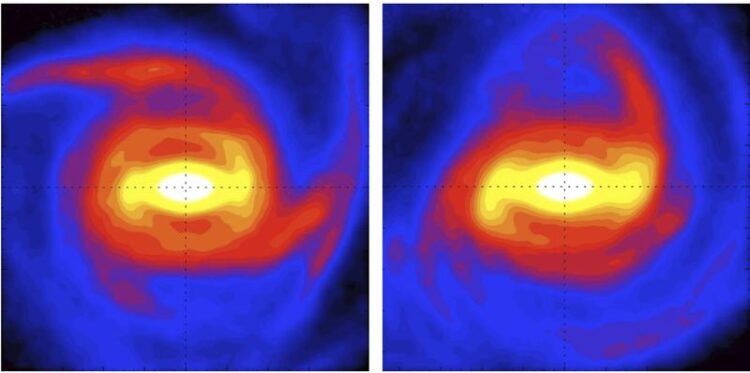Cosmic dance: A solution to the Galactic bar paradox

If the Galactic bar and the spiral arms are disconnected, the bar shows its true and smaller structure (left). Every time they meet, the bar appears longer and its rotational speed lower (right).
T. Hilmi
The very heart of our Milky Way harbours a large bar-like structure of stars whose size and rotational speed have been strongly contested in the last years. A new study has found an elegant solution to the discrepancies found in different observational studies, using the fact that the bar and spiral arms move at different rotational velocities, encountering each other about every 80 Million years. As the faster-rotating bar approaches a spiral arm, it appears to be much longer and their ongoing mutual attraction due to gravity periodically varies both their rotational speeds.
While studies of the motions of stars near the Sun suggest the bar is small and rapidly rotating, direct observations of the Galactic central region find it to be significantly longer and slower. An international team of scientists led by Tariq Hilmi of the University of Surrey and Ivan Minchev of the Leibniz Institute for Astrophysics Potsdam (AIP) has found a solution to this apparent discrepancy. The team looked at the most recent stages of the Milky Way evolution. Analysing state-of-the-art galaxy formation simulations of the Milky Way, the scientists now showed that both the bar’s size and its rotational speed fluctuate in time, causing the bar to appear up to twice as long and 20 percent faster at certain times.
These bar pulsations result from its regular encounters with the Galactic spiral arms, in what can be described as a “cosmic dance”. Spiral arms are density waves within our Galaxy and move at a similar velocity as the Sun. A full rotation around the center of the Milky Way takes about 220 million years, while the central bar needs only about 60 million years.
As the faster rotating bar approaches a spiral arm, their mutual attraction due to gravity makes the bar slow down and the spiral arm speed up. Once connected, the two structures move as one and the bar appears much longer than it actually is. As the dancers split apart, the bar speeds up while the spiral arm slows back down.
“The controversy of the Galactic bar found in observational studies can be simply resolved if we happen to be living at a time when the bar and spiral arms are connected, giving the illusion of a large and slow bar, while the motion of stars near the Sun is governed by the bar’s true, much smaller size,” says Ivan Minchev. Indeed, recent observations have shown that the inner Milky Way spiral arm is in fact connected to the bar.
The majority of spiral galaxies like our Milky Way host a large bar in their center. The gravitational pull of this Galactic bar shapes the stellar orbits not just near it, but all the way to our Sun and beyond. Knowledge of the true bar size and rotational speed is crucial for understanding how our Galaxy formed and evolved, as well as how galaxies form bars throughout the universe.
But unlike in other galaxies, the Milky Way bar is hard to observe directly, owing to our position in the galactic disk. Data from the forthcoming 3rd data release of the Gaia mission will be able to test this model further, and future missions will discover if the dance goes on in other galaxies across the Universe.
Wissenschaftliche Ansprechpartner:
Dr. Ivan Minchev, 0331 7499 259, iminchev@aip.de
Originalpublikation:
Tariq Hilmi, Ivan Michev et al. (2020): Fluctuations in galactic bar parameters due to bar–spiral interaction. MNRAS 497, 933–955 https://doi.org/10.1093/mnras/staa1934
Weitere Informationen:
https://cloud.aip.de/index.php/s/Zwwc3jsnDHYj3SK Images & Movies
https://ras.ac.uk/news-and-press/research-highlights/galactic-bar-paradox-resolv… Press release of the Royal Astronomical Society
Media Contact
All latest news from the category: Physics and Astronomy
This area deals with the fundamental laws and building blocks of nature and how they interact, the properties and the behavior of matter, and research into space and time and their structures.
innovations-report provides in-depth reports and articles on subjects such as astrophysics, laser technologies, nuclear, quantum, particle and solid-state physics, nanotechnologies, planetary research and findings (Mars, Venus) and developments related to the Hubble Telescope.
Newest articles

Decoding Cancer: 40 Years of Breakthroughs in Genetic Research
Cancer in children and adolescents is rare. Nevertheless, malignant diseases are still one of the most common causes of death in this age group. Survivors of childhood or adolescent cancer…

Let’s Think Before the First Drink: How Early Substance Use Might Lead to Brain Structure Differences Among Adolescents
Many differences appeared to exist prior to any substance use, pointing to the role brain structure may play in substance use risk, NIH-supported study suggests. Studies reveal factors that expose…

Combating Kidney Cancer Using Enhanced Immunotherapies
Medical University of South Carolina Hollings Cancer Center researcher receives Department of Defense Early Career Scholar Award to improve immune therapies by targeting resistant kidney tumors. A Medical University of…



